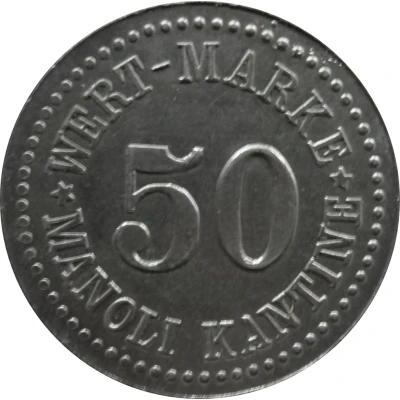


© Willem63 (CC BY-NC-SA)
50 Pfennigs - Berlin (Manoli Kantine) ND
| Zinc | 3.6 g | 25.4 mm |
| Issuer | Prussian province of Berlin (German notgeld) |
|---|---|
| Type | Standard circulation coin |
| Value | 50 Pfennigs (50 Pfennige) (0.50) |
| Currency | Mark (1914-1924) |
| Composition | Zinc |
| Weight | 3.6 g |
| Diameter | 25.4 mm |
| Thickness | 1.3 mm |
| Shape | Round |
| Technique | Milled |
| Orientation | Medal alignment ↑↑ |
| Demonetized | Yes |
| Updated | 2024-10-04 |
| Numista | N#317470 |
|---|---|
| Rarity index | 97% |
Reverse
Pearl rim, with denomination centered
Script: Latin
Lettering: 50
Edge
Plain
Comment
Menzel: BBBFa: Zigarettenfabrik (Cigarette factory)
Manoli was the name of a German cigarette factory. It was founded by Jakob Mandelbaum (* 1859; † October 23, 1918) in Berlin, initially under the name Cigarette Factory Argos, and in 1897 it is said to have been named after Jakob Mandelbaum's wife Ilona Mandelbaum (read backwards). The origin of the name cannot be proven with certainty, because Jacob Mandelbaum's wife's name was Rosa and she was born in Jotzen in 1857. There are suggestions that Manoli may have been a nickname of Jacob Mandelbaum.
Another variant of the naming names a foreign language as the origin, in which Mandelbaum is translated as Manoli.
The company was known for its excellent packaging design. The Manoli corporate logo, found on merchandise, corporate trucks, window displays and promotional materials, is often cited as an early example of corporate design.
Interesting fact
One interesting fact about the 50 Pfennigs - Berlin (Manoli Kantine) ND coin is that it was part of a series of emergency coins minted during a period of economic crisis in Germany, specifically in the Prussian province of Berlin, in the early 20th century. These coins were made of zinc, a less valuable metal than the traditional copper or silver, and were designed to address the shortage of small denomination coins in circulation. Despite their humble origins, these coins have become sought-after collectibles among numismatists today.



